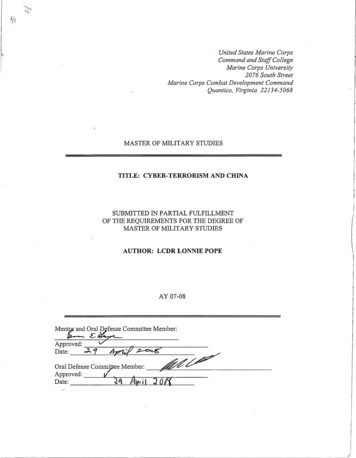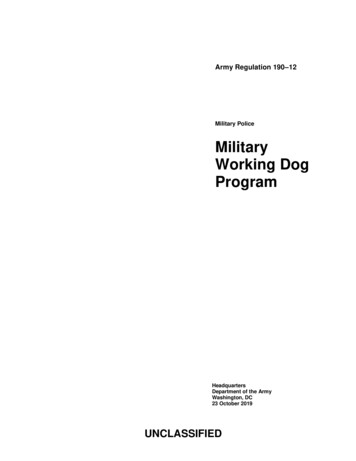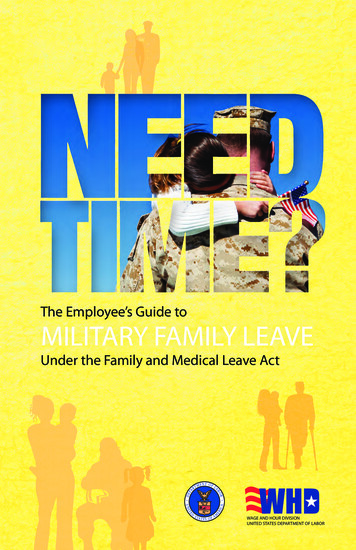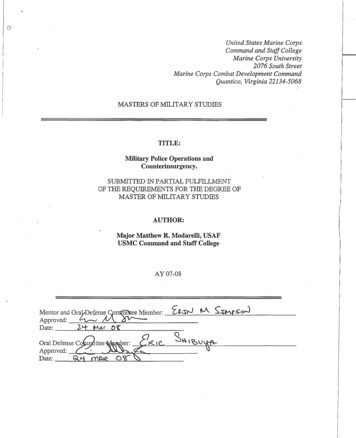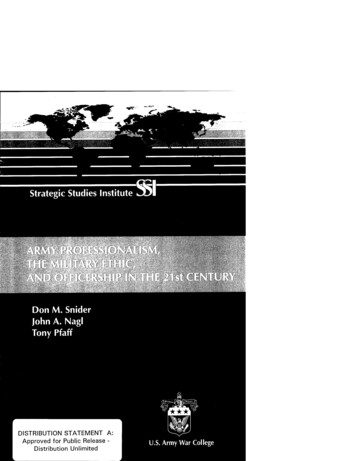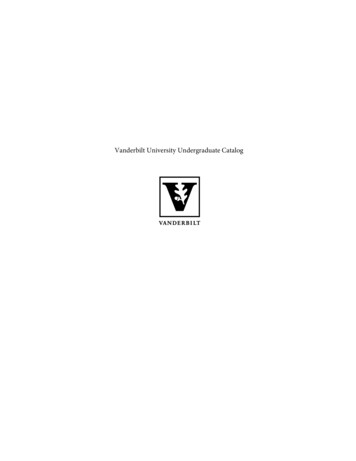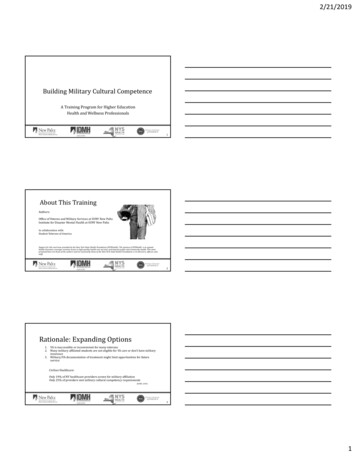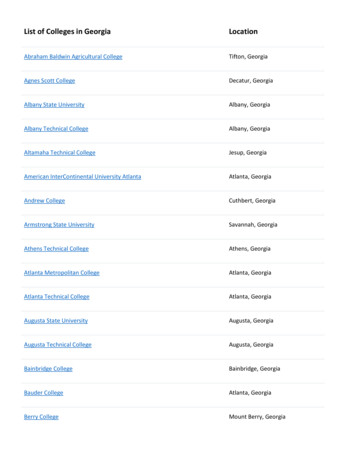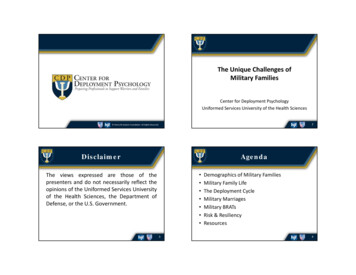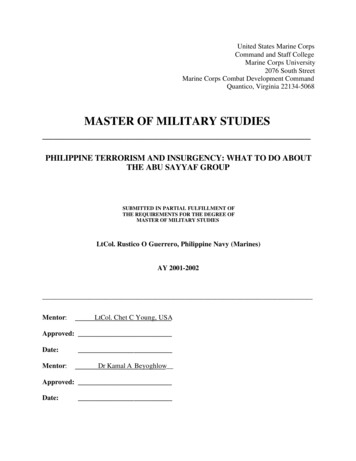
Transcription
United States Marine CorpsCommand and Staff CollegeMarine Corps University2076 South StreetMarine Corps Combat Development CommandQuantico, Virginia 22134-5068MASTER OF MILITARY STUDIESPHILIPPINE TERRORISM AND INSURGENCY: WHAT TO DO ABOUTTHE ABU SAYYAF GROUPSUBMITTED IN PARTIAL FULFILLMENT OFTHE REQUIREMENTS FOR THE DEGREE OFMASTER OF MILITARY STUDIESLtCol. Rustico O Guerrero, Philippine Navy (Marines)AY 2001-2002Mentor:LtCol. Chet C Young, USAApproved:Date:Mentor:Dr Kamal A BeyoghlowApproved:Date:
REPORT DOCUMENTATION PAGEForm Approved OMB No.0704-0188Public reporting burder for this collection of information is estibated to average 1 hour per response, including the time for reviewing instructions, searching existing data sources, gathering and maintaining the data needed, and completingand reviewing this collection of information. Send comments regarding this burden estimate or any other aspect of this collection of information, including suggestions for reducing this burder to Department of Defense, WashingtonHeadquarters Services, Directorate for Information Operations and Reports (0704-0188), 1215 Jefferson Davis Highway, Suite 1204, Arlington, VA 22202-4302. Respondents should be aware that notwithstanding any other provision oflaw, no person shall be subject to any penalty for failing to comply with a collection of information if it does not display a currently valid OMB control number. PLEASE DO NOT RETURN YOUR FORM TO THE ABOVE ADDRESS.1. REPORT DATE (DD-MM-YYYY)2. REPORT TYPE12-04-2002Student research paper4. TITLE AND SUBTITLEPhilippine Terrorism and Insurgency: What to do About the ABU SAYYAF GroupUnclassified6. AUTHOR(S)Guerrero, Rustico O. ;7. PERFORMING ORGANIZATION NAME AND ADDRESSUSMC Command and Staff CollegeMarine Corps University, MCCDC2076 South StreetQuantico, VA22134-50689. SPONSORING/MONITORING AGENCY NAME AND ADDRESSUSMC Command and Staff CollegeMarine Corps University2076 South Street, MCCDCQuantico, VA22134-506812. DISTRIBUTION/AVAILABILITY STATEMENTAPUBLIC RELEASE,13. SUPPLEMENTARY NOTES14. ABSTRACTSee report.15. SUBJECT TERMS16. SECURITY CLASSIFICATION OF:17. LIMITATIONOF ABSTRACTPublic Releasea. REPORTUnclassifiedb. ABSTRACT c. THIS PAGEUnclassifiedUnclassified3. DATES COVERED (FROM - TO)xx-xx-2001 to xx-xx-20025a. CONTRACT NUMBER5b. GRANT NUMBER5c. PROGRAM ELEMENT NUMBER5d. PROJECT NUMBER5e. TASK NUMBER5f. WORK UNIT NUMBER8. PERFORMING ORGANIZATION REPORTNUMBER10. SPONSOR/MONITOR'S ACRONYM(S)11. SPONSOR/MONITOR'S REPORTNUMBER(S)18.19. NAME OF RESPONSIBLE PERSONNUMBER EM114, (blank)OF PAGES lfenster@dtic.mil6919b. TELEPHONE NUMBERInternational Area CodeArea Code Telephone Number703767-9007DSN427-9007Standard Form 298 (Rev. 8-98)Prescribed by ANSI Std Z39.18
Form ApprovedOMB No. 0704-0188REPORT DOCUMENTATION PAGEPublic reporting burden for this collection of information is estimated to average 1 hour per response, including the time for reviewing instructions, searching existing data sources, gathering and maintaining thedata needed, and completing and reviewing this collection of information. Send comments regarding this burden estimate or any other aspect of this collection of information, including suggestions for reducingthis burden to Department of Defense, Washington Headquarters Services, Directorate for Information Operations and Reports (0704-0188), 1215 Jefferson Davis Highway, Suite 1204, Arlington, VA 222024302. Respondents should be aware that notwithstanding any other provision of law, no person shall be subject to any penalty for failing to comply with a collection of information if it does not display a currentlyvalid OMB control number. PLEASE DO NOT RETURN YOUR FORM TO THE ABOVE ADDRESS.1. REPORT DATE (DD-MM-YYYY)2. REPORT TYPE12-04-20024. TITLE AND SUBTITLE3. DATES COVERED (From - To)MASTER OF MILITARY STUDIES THESIS5a. CONTRACT NUMBERUPHILIPPINE TERRORISM AND INSURGENCY: WHAT TO DO ABOUT THE ABUSAYYAF GROUP5b. GRANT NUMBER5c. PROGRAM ELEMENT NUMBER6. AUTHOR(S)5d. PROJECT NUMBERLTCOL RUSTICO O. GUERRERO PN(M)PHILIPPINE MARINE CORPS5e. TASK NUMBER5f. WORK UNIT NUMBER7. PERFORMING ORGANIZATION NAME(S) AND ADDRESS(ES)8. PERFORMING ORGANIZATION REPORTNUMBERUSMC COMMAND AND STAFFCOLLEGE2076 SOUTH STREET, MCCDC,QUANTICO, VA 22134-50689. SPONSORING / MONITORING AGENCY NAME(S) AND ADDRESS(ES)10. SPONSOR/MONITOR’S ACRONYM(S)USMC COMMAND AND STAFFCOLLEGE2076 SOUTH STREET, MCCDCQUANTICO, VA 22134-506811. SPONSOR/MONITOR’S REPORTNUMBER(S)12. DISTRIBUTION / AVAILABILITY STATEMENTNO RESTRICTIONS13. SUPPLEMENTARY NOTES14. ABSTRACT The paper is about the Philippine terrorism and insurgency problem. It answers thequestion: Is the current Philippine government counter terrorism strategy effective againstthe Abu Sayyaf Group(ASG)? If not, what can be done about it? As a background, the currentnational security threat groups such as the communist New Peoples' Army(NPA), thesecessionist Moro Islamic Liberation Front (MILF), to include other minor threat groups wereexamined along with the history of Filipino Muslims in southern Philippines. Using theanalytical framework of Bard O'Neill, the ASG was analyzed as to its history, organization,logistics, tactics, and training. Variables affecting the operational environment such asterrain, climate, infrastructure, political culture, socio-economic conditions, domestic andexternal popular support, and the criminal justice and law enforcement system were likewiseanalyzed. The Philippine government's strategy of "Holistic approach" is a two-prongedapproach towards insurgency and terrorism. It is in the right direction, but itseffectiveness cannot be gauged yet. The use of military force is necessary at this stage, buta multidimensional approach to get at the root causes of the terrorism must be done toreverse the unfavorable environment where terrorism thrives.I15. SUBJECT TERMS:PHILIPPINE TERRORISM AND INSURGENCY, ABU SAYYAF GROUP, PHILIPPINE COUNTER TERRORIST STRATEGY16. SECURITY CLASSIFICATION OF:Unclassifieda. REPORTb. ABSTRACT17. LIMITATIONOF ABSTRACT18. NUMBEROF PAGESc. THIS PAGE19a. NAME OF RESPONSIBLE PERSON19b. TELEPHONE NUMBER (include area58code)Standard Form 298 (Rev. 8-98)Prescribed by ANSI Std. Z39.18
10 April 2002Executive SummaryTitle: PHILIPPINE TERRORISM AND INSURGENCY: WHAT TO DO ABOUT THE ABUSAYYAF GROUPAuthor: LtCol. Rustico O Guerrero, Philippine Navy (Marines)Thesis: This paper addresses the following research question: Is the current PhilippineGovernment counter terrorism strategy effective against the Abu Sayyaf Group? If not, whatcan be done about it?Discussion: To provide a clear background on the problem, there is need to get an insight intothe Muslims struggle in the Philippines, from the time Islam was introduced, up to thecontemporary involvement of Filipino Muslims in secessionist and terrorist movements. Threegroups that are currently considered as national security threats have perpetrated acts ofterrorism. These are the communist New Peoples' Army (NPA), the secessionist Moro IslamicLiberation Front (MILF), and the terrorist Abu Sayyaf Group (ASG). Philippine PresidentGloria Macapagal Arroyo has tagged the latter as a group of bandits, and later as terrorists. Thegovernment is conducting peace talks with the first two rebel groups. Massive militaryoperations against the ASG are ongoing with the assistance of the American Special OperationsForces, while an American couple and one Filipino nurse are still in captivity. Other threatscome from minor groups such as criminal elements, and the renegade bands of Moro NationalLiberation Front (MNLF).Bard O’Neill’s framework for analyzing insurgency and terrorism was used to examinethe ASG. The variables and factors affecting the ASG and the operational environment show thecritical vulnerabilities of the terrorist group and the weaknesses in the government system.Identifying these and assessing the effectiveness of the government's counter terrorist strategy isimportant, since it has implications on the international, regional, political, and socio-economicaspects. The inadequacies of the current systems and weaknesses in the implementation aspectswere also focused.Conclusion: The Philippine government's counter terrorism strategy against the ASG is a twopronged approach towards insurgency and terrorism. Its effectiveness cannot be gauged yet butthe strategy is a step in the right direction. It is a long term and expensive solution hence it needsmore time and resources in order to be effective. A vigorous and sustained effort in the politicaland socio-economic aspects is necessary to address the dysfunctions. The use of military actionswhen terrorist acts occur is necessary at this stage, but it cannot address the problem completelyas it offers only a short-term solution. Using a multi-dimensional approach to get at the rootcauses and reversing the unfavorable environment where terrorism thrives, are the most logicalapproach in tackling the ASG.
DISCLAIMERTHE OPINIONS AND CONCLUSIONS EXPRESSED HEREIN ARE THOSE OF THEINDIVIDUAL STUDENT AUTHOR AND DO NOT NECESSARILY REPRESENTTHE VIEWS OF EITHER THE MARINE CORPS COMMAND AND STAFFCOLLEGE OR ANY OTHER GOVERNMENTAL AGENCY INCLUDING THEGOVERNMENT OF THE REPUBLIC OF THE PHILIPPINES. REFERENCES TOTHIS STUDY SHOULD INCLUDE THE FOREGOING STATEMENTi
PrefaceWriting on a very current topic on terrorism, particularly in the light of theSeptember 11, 2001 terrorist attacks in the United States of America, could not have beenmore relevant and timely. The terrorist group in the Philippines, the Abu Sayyaf, hasrecently been in the limelight after its links with the Al Qaeda terrorist network wasexposed. This paper analyzes the counter terrorist strategy of the Philippine governmentin response to the threat. It answers the question: Is the current Philippine government'scounter terrorism strategy effective against the Abu Sayyaf Group (ASG)? If not, whatcan be done about it?The problem on the ASG is more complex than what appears on the surface as amere terrorist group. To put the issue on a proper perspective, I looked into the FilipinoMuslims from the time Islam was introduced in Southern Philippines, up to theirinvolvement in the current secessionist and terrorist movements. This includes the otherthreat groups that affect the Philippines national security. The ASG was analyzed usingthe analytical framework of Bard O'Neill.Considering all implications on theinternational and regional scene, the ASG is analyzed as a product of an environment thatis susceptible to insurgency and terrorism. The government's counter terrorist strategy isassessed to be in the right direction vis-à-vis the threat. However, its effectiveness cannotbe measured yet. The neutralization of the ASG is critical to achieve the government'sgoals. Based on the analysis, I recommended some additional measures to complementthe current administration's counter terrorism strategy. These are inputs for the futurecommanders, planners, and even the war fighters who will be facing this threat.ii
My interest in this topic started as early as August 2001 and was mainlyinfluenced by my continuous exposure and experience in combating terrorism in my owncountry, the Philippines. My career in the Marine Corps from the platoon, up to thecommand of a battalion, and in field intelligence jobs, has been devoted mostly to counterterrorism. My recent two-and-a-half years in command of a marine battalion, two yearsof which were in the province of Sulu, exposed me to the different problems, factors, andchallenges in confronting the Abu Sayyaf Group. I have read books and articles on Islamand the history of Filipino Muslims, as well as conferred and interacted with the differentsectors of the populace of Sulu and adjoining areas in the hope of finding the rightanswers. Now armed with an analytical framework on how to address terrorism, a moreeffective approach could be formulated. Though some of the recommended solutionshave been proven to be effective, the analytical approach to both the terrorist group andto the counter terrorism strategy did facilitate the formulation of new solutions.I am indebted to my mentor and faculty advisor: Dr Kamal Beyoghlow andLieutenant Colonel Chet C Young, USA, both of the Marine Corps University Commandand Staff College faculty.Dr Beyoghlow mentored my work with utmostprofessionalism and patience, for which I am grateful. I am also grateful to my sponsor,LCdr Steve Unger USN for his support and encouragement. Many thanks to my wifeMaricor, and my daughter Mia, for their patience and understanding during the late nightsI spent while writing this paper.iii
TABLE OF CONTENTSPageDISCLAIMERiPREFACEiiTHE PHILIPPINE TERRORIST THREAT1BackgroundFilipino Muslims Struggle (before Abu Sayyaf)Contemporary Threats (1990-2001)THE ABU SAYYAF GROUP141014Organization and UnityLogistics, Tactics and Training of the ASGTerrain, Climate and InfrastructurePolitical CultureSocio-Economic ConditionsPopular Domestic SupportPopular External SupportCriminal Justice and Law EnforcementTHE STRATEGY OF HOLISTIC APPROACHThe Military Response17182125262830333541CONCLUSION46Assessment of Policy Effectiveness46CITED 22324iv
CHAPTER ITHE PHILIPPINE TERRORIST THREATBackgroundThe problem of terrorism has been seriously plaguing the Philippine governmentsince the start of the communist insurgency in the 60’s. The use of terrorism in theconduct of an armed revolution, in order to set up a communist government or to secede apart of the country, had caused much trouble and casualties.Bard O’Neill, an authority on insurgency and terrorism, defined terrorism as aform of warfare in which violence is directed primarily against non-combatants (usuallyunarmed civilians), rather than operational military and police forces or economic assets(public or private). 1 Compared to guerilla units, terrorist units are smaller and covert.Their actions range from assassinations, bombings, arson, kidnapping, and hijacking,with most of the victims or targets chosen for political or propaganda impact.International terrorism of today, has crossed borders, are carried out by non-state actors,and even sponsored by some states. As a form of warfare normally associated withinsurgent conflicts, terrorism sits well with groups that cannot match the targetgovernment’s military forces.Thus, asymmetric attacks conducted against aconventional force have the same devastating effect as that of an attack in a battlegroundbetween symmetrical forces.1Bard O’Neill, Insurgency and Terrorism, Inside Modern Revolutionary Warfare (Washington: Brassey’s(U.S.), Inc., 1990), 24.1
Insurgency, on the other hand, is defined as a struggle between a nonruling groupand the ruling authorities in which the nonruling group consciously uses politicalresources (e.g. organizational expertise, propaganda, and demonstrations) and violence todestroy, reformulate, or sustain the basis of legitimacy of one or more aspects of politics. 2Using that definition, the communist New People’s Army (NPA) is an insurgent force. Itcan be further classified as egalitarian type since it seeks to impose a new system andradically transform the social structure within an existing political community. 3The Moro Islamic Liberation Front (MILF) in Southern Philippines is asecessionist group that wants to carve out a separate state with their own form ofgovernment and under Islamic rules. The two aforementioned groups threatening thePhilippines’ national security have clearly defined goals, organizational structure, and theresources to be considered as insurgent groups, based on universally accepted definitions.They also have the equivalent governing structure, just like a “shadow government."The Abu Sayyaf Group (ASG) has been identified as a group of bandits and lateras terrorists. 4 This is due to its use of kidnapping, murder, bombings, assassinations, andbeheadings to meet their ends. While this appears as a more popular and commonclassification when compared with the typical insurgent group such as the CommunistParty of the Philippines/New Peoples Army (CPP/NPA) or the MILF, there areparameters by which a group can be classified as insurgent. Among the seven types ofinsurgencies described by Bard O’Neill, the ASG can also be called as insurgents. It isunder the traditionalist and secessionist types, since it espouses the establishment of an2Bard O’ Neill, 13.Bard O’ Neill, 18.4Philippine President Gloria Macapagal Arroyo, Interview on TV during her visit to Washington, DC,U.S.A. on November 20, 2001.32
Islamic state, separate from the Republic of the Philippines. It is traditional in the sensethat like most religion-based insurgent groups, the ASG purportedly wages actions in thename of Islam. It is a secessionist group similar to the MILF if classified in terms of itsavowed goal of a separate state. This claim of creating a separate Islamic state is notbacked up with particular documents, or with sufficient organizational structureresembling that of the CPP/NPA and the MILF. On the basis of several variables bywhich the ASG will be described and analyzed in this chapter, their categorization as aterrorist group may be more appropriate in the light of their purely military-typeorganization, and a consistent engagement in criminal activities, among others. Theiravowed goal and known methods really differ. A guerrilla attacks soldiers in war while aterrorist attacks high impact targets in peacetime for propaganda. 5 Ironically, the focus ofASG attacks is civilians and not the military, which is the greatest threat to its goal.Clearly, the intent and method of achieving its goal is through the financially rewardingkidnapping venture, and other terrorist activities.A proper perspective on the Abu Sayyaf Group can be more clearly appreciated ifthere is an understanding first of the struggle of the Muslims in Southern Philippines.Knowing and understanding the roots of the problem in Southern Philippines could helpin the analysis of this group, and to formulate ways to address the problem.5Christopher C. Harmon, Terrorism Today (Oregon: Frank Cass Publishers, 2001) 193.3
Filipino Muslims Struggle (Before Abu Sayyaf)“Moro history is gory. These people were not really beaten after three hundredyears of Spanish effort. Americans brought them to terms only after decisive, bloodymassacres which aroused the American public because women and children were doneaway with along with the men.”Florence Horn 6The history of the Republic of the Philippines had been replete with conflicts bothagainst foreign aggressors and amongst Filipinos. From the Spanish "conquistadors," theAmerican colonialists, up to the Japanese imperialists, there have been quite longoccurrences of Filipino resistance. The Philippine Islands was discovered on 16 March1521 by the Portuguese circumnavigator Ferdinand Magellan. Magellan worked for theSpanish empire and was killed in the island of Mactan by fierce warriors led by Lapulapu. The archipelago was later named Las Islas Filipinas, after Spanish King Philip II. 7From 1565, the Spaniards imposed their control and influence by establishing their firstpermanent settlement in this new possession. 8 There is, however, a different story for theislands in Mindanao.In the 14th century, the first Arab missionaries arrived andestablished the first mosque in Simunul Island, Tawi-Tawi, located far south of the mainisland of Mindanao. 9 This was a result of the interaction among Arab traders plying theSulu seas and the island inhabitants. From there, the Islamic faith was propagatedtoother islands in Mindanao. Florence Horn describes the Muslim Filipinos as “MalayanIndonesian people, like other Filipinos, the so-called Moros had been converted to6Florence Horn, Orphans of the Pacific (New York, Cornwall Press, 1941), 150.EF Benson, Ferdinand Magellan (London,John Lane The Bodley Head Ltd, 1929),175.8EF Benson, 177.9Philippine Information, Philippine Government, URL http://www.gov.ph/philinfo/genreralinfo.asp accessed December 19, 2001. Tawi-Tawi is formerly a part of Sulu, but is now a separate province.74
Mohammedanism long before Magellan set foot on the Islands."10 Nevertheless, it wasthe Spaniards, unlike the Arabs who settled in the South, which made a lasting imprint byspreading the Catholic faith in most parts of the archipelago.There were considerable effort, resources, and lives lost in the colonization ofMindanao. It was due to the warrior character of the Muslim tribes who fought fiercely,particularly the Taosugs11 of Sulu. But as the Spanish tried to impose their rule in thesouthern islands, Moro pirates continued to roam the seas, raiding shipping fearlessly andruthlessly, not only around the Philippines, but also around Borneo and Dutch East Indiesas well. 12 These Muslim tribes have been able to maintain their tribes’ hierarchy up untiltoday. However, they are not considerably as powerful and influential as before theMuslim rebellion in the 1970’s.On April 25, 1898, the Spanish-American war erupted and culminated in thevictory of Admiral George Dewey over the Spanish fleet in the Battle of Manila Bay. 13Consequently, the Treaty of Paris was concluded and the Philippine Islands was ceded tothe United States of America in the amount of Twenty Thousand Dollars ( 20,000.00). 14This time, the American type of colonization began, which U.S. President WilliamMcKinley termed as “Benevolent Assimilation".15It was an earnest military effort to winthe confidence, respect, and affection of the inhabitants of the Philippines.10Florence Horn,150.Philippines country study, URL http://1cweb2.loc.gov/cgi-bin country study accessed December 19,2001. Taosug, a Muslim tribe in Sulu, was the first group to adopt Islam in the 14th century. Known for itswarrior character, this tribe is one of the ten sub-groups identified on the basis of language. Others areMaranao of the two Lanao provinces, Maguindanao of Central Mindanao provinces, and the smaller tribes:Samal, Badjao, Yakan, Iranon, Sangir, Melabugnan, and Jama Mapun.12Florence Horn, 151.13Spanish-American War/War of Philippine Independence 1898-1901,URL http://www.ualberta.ca/ vmitchel/fw4.html accessed on August 11,2001. 1.14Spanish-American War.115
Unfortunately, the Filipino revolutionaries were fighting for independence, not a newcolonial master. This led to a 4-year conflict between the Filipino revolutionaries led byGeneral Emilio Aguinaldo and the American forces. With Aguinaldo captured and theFilipinos worn down, the U.S. finally declared the “Philippine Insurrection” over by July4, 1902.16 Nevertheless, the war was far from over in Mindanao, since the fierce Muslimtribes refused to be subjugated by another colonizer. Two bloody and lopsided battlesbetween the Americans and Moros were fought in Mount (Bud) Daho and Mount Bagsakin 1906 and 1913 respectively. 17The Americans were however very clever in trying towin over the “sultans” and the “datus”18 , who were the key figures in the tribal set-up inthe South. The American Colonial Governor Frank W. Carpenter who tried to learn theculture, read the Koran and attempted to understand the Muslim law, exemplified this.19During the Second World War, the Japanese Imperial Army occupied the islands after theAmerican debacle in Bataan and Corregidor. The island of Mindanao was important tothe Japanese forces since they used it as their base for further invasion of the NetherlandsEast Indies (Borneo).They occupied the city of Davao along with other areas inmainland Mindanao, and the island of Jolo in Sulu. True to their reputation, the Muslimsin these parts of Mindanao continued the struggle through guerilla warfare. In Sulualone, the Japanese had a hard time venturing out into the remote areas of the island since15Stuart Creighton Miller, "Benevolent Assimilation" The American Conquest of the Philippines 1899-1903(New Haven, Yale University Press, 1982), 23.16Crucible of Empire-PBS Online, URL http://www.pbs.org/crucible/timeline accessed on September25, 2001.17Florence Horn, 153. The word “Bud” in the local dialect in Sulu means “mountain”. Both mountains arefound in the main island of Jolo in Sulu.18Philippines Country Study. The traditional structure of Moro society focused on a Sultan who was both asecular and a religious leader whose authority was sanctioned by the Quran. The family lineage isconsidered until today. The datus are the communal leaders who measured power by the number offollowers. Sultans exercise suzerainty over the datus in his territory.19Florence Horn, 154.6
they were always at the risk of being ambushed. Not even their confinement to key towncenters where they established bases spared them from raids and harassment by the localguerillas. Before the American liberators came, the Japanese troops in the island werealmost annihilated by the Muslim guerilla groups who were supported by Americanarmaments secretly landed via submarines. 20From the time of liberation by the Americans, to the subsequent Philippineindependence in July 4, 1946, there was no major conflict of national significance inMindanao, as well as in the rest of the islands.As the incipient communist Hukmovement in Luzon started to bother the young Philippine government in the 1950’s,only the roving bands of pirates and the typical inter-tribal conflicts caused trouble inMindanao.The more significant piracy was in the Lanao-Cotabato provinces inmainland Mindanao.In the late 60's, the Moro National Liberation Front (MNLF) was organized as asister organization of previous Muslim association called the Muslim IndependenceMovement (MIM) later renamed as Mindanao Independence Movement.PowerfulMuslim leaders and politicians who advocated the separation of Mindanao since theCommonwealth period then headed the latter. The MNLF was born out of this politicaland armed independence movement.Founded by Nur Misuari, a Professor in theUniversity of the Philippines, along with two other leaders, they led a group of 90Filipino Muslims, collectively called as "Batch 90", that trained in Pulao Pangkor Islandin Sabah, Malaysia. 21 Aside from providing the sanctuary and training base, Malaysian20Based on a limited issue book written by a Philippine guerilla leader in Sulu-Tawi-Tawi islands I read in1999. I borrowed it from a former Captain who commanded a guerilla company during WWII, and who iscurrently residing in Jolo, Sulu.21Philippine Marine Corps, Intelligence Brief, Moro National Liberation Front, undated.7
Army officers trained them on guerilla warfare. This support was apparently expectedsince religion and long association with neighboring islands of both countries throughcenturies of trade between its people, were the common denominators. More evident isthe dispute between the Philippine and the Malaysian government over the ownership ofSabah, an island in Malaysia. From this group emerged the nucleus of the MNLF and itsmilitary arm, the Bangsa Moro Army (BMA). Other batches of trainees followed untilthey slipped back to Mindanao and started underground activities of recruitment,orientation, and training. When President Ferdinand Marcos declared Martial Law in1972, the harsh rule further deteriorated the conditions. 22 The MNLF exploited this byspreading anti-government propaganda alleging that the government was out toChristianize Mindanao by force. This became a serious internal security problem whenthe MNLF started the conflict in Marawi City on October 21, 1972, marking thebeginning of the Moro "Jihad" against the Philippine Government. 23In 1973, Misuari went to the Middle East via Malaysia to solicit support fromMuslim countries like Libya. In an effort to persuade the MNLF leadership to thenegotiating table, the government sent emissaries to Jeddah, Saudi Arabia in 1974. Thisproved effective and by 1977, they signed a ceasefire agreement in Zamboanga City.This was based on the Tripoli Agreement signed by Misuari and the Philippine DefenseUndersecretary in Libya in 1976. 24 However, sporadic clashes between governmenttroops stationed in the islands and the rebels occurred even after the agreement.22Proclamation 1081, declaring Martial Rule in the entire Philippines was made on September 21, 1972, tocontain the communist insurgency threat. It was lifted in 1981.23PMC Intelligence Brief, MNLF, undated.24Fred R Von der Mehden, Two Worlds of Islam, Interaction between Southeast Asia and the Middle East(Florida, University Press of Florida, 1993), 56-57.8
In 1986, Misuari, who was then in self-exile in Saudi Arabia, was invited by thenPresident Corazon Aquino to return to the country and find new solutions to theMindanao problem.Upon his return, Misuari still insisted on his demand for anindependent Muslim republic. Expectedly, there were quarters in the military that viewedthe move for Misuari’s return as a resurrection of a dying movement. Aquino's attemptwas to take the peaceful path so the economy could develop. The strategy did provide along needed respite from the major clashes between government troops and the rebels,and the scarce resources were channeled to activities in pursuit of peace anddevelopment.In 1975, the Vice Chairman of the MNLF, Abdul Salam Hashim (commonlyknown as Hashim Salamat), due to policy and personal differences with Misuari,dissociated himself and formed his own faction. The group later became known as theMoro Islamic Liberation Front (MILF) in 1984.Meanwhile, Hashim's replacement,Dimasangkay Pundato, later on dissociated himself from the MNLF and formed his ownMNLF Reformist Group. 25The MILF continued the armed struggle to carve an Islamic state in Mindanao.Its armed component, the Bangsa Moro Islamic Armed Forces was slowly built up intomilitary formations from battalion up to division size. 26This group only resurrected instrength in the la
Marine Corps University 2076 South Street, MCCDC Quantico, VA22134-5068 10. SPONSOR/MONITOR'S ACRONYM(S) 11. SPONSOR/MONITOR'S REPORT NUMBER(S) . both of the Marine Corps University Command and Staff College faculty. Dr Beyoghlow mentored my work with utmost professionalism and patience, for which I am grateful. I am also grateful to my sponsor,
